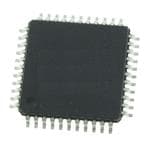PIC24FJ64GA004T-I/PT
16-bit microcontrollers with 64KB flash memory in 44-pin TQFP packages
Manufacturer: microchip
series introduction
# Introduction to the PIC24FJ64GA004T - I/PT Product Series
## 1. Overview
The PIC24FJ64GA004T - I/PT is a member of Microchip Technology's PIC24F family of 16 - bit microcontrollers. These microcontrollers are designed to offer a balance of performance, power efficiency, and integrated features, making them suitable for a wide range of applications.
## 2. Key Features
### 2.1 Core and Performance
- **16 - bit RISC Core**: The PIC24FJ64GA004T - I/PT is built around a high - performance 16 - bit RISC core. This core provides efficient execution of instructions, enabling the microcontroller to handle complex tasks with relative ease. It has a rich instruction set that includes arithmetic, logical, and bit - manipulation operations, which are essential for various computational tasks.
- **Operating Frequency**: It can operate at a maximum frequency of up to 32 MHz. This relatively high clock speed allows for fast data processing and quick response times, making it suitable for applications that require real - time control.
### 2.2 Memory
- **Flash Program Memory**: The microcontroller comes with 64 KB of in - system self - programmable Flash memory. This non - volatile memory is used to store the program code. The in - system self - programming feature allows for easy firmware updates, which is crucial for product development and maintenance.
- **RAM**: It has 4 KB of RAM, which is used for storing variables, intermediate results, and data buffers during program execution. The sufficient amount of RAM enables the microcontroller to handle moderately complex algorithms and data - intensive tasks.
### 2.3 Peripherals
#### 2.3.1 Timers
- **Multiple Timers**: The PIC24FJ64GA004T - I/PT is equipped with several timers, including 16 - bit and 32 - bit timers. These timers can be used for a variety of purposes such as generating accurate time delays, measuring time intervals, and controlling PWM (Pulse Width Modulation) signals. For example, in motor control applications, the timers can be used to generate PWM signals to control the speed and direction of the motor.
#### 2.3.2 Communication Interfaces
- **UART (Universal Asynchronous Receiver - Transmitter)**: It has a UART interface, which is commonly used for serial communication. This allows the microcontroller to communicate with other devices such as sensors, displays, or other microcontrollers over a serial link. The UART supports various baud rates, making it compatible with a wide range of external devices.
- **SPI (Serial Peripheral Interface)**: The SPI interface provides a high - speed serial communication option. It is often used for communicating with external memory devices, sensors, or other high - speed peripherals. The SPI interface allows for full - duplex communication, enabling fast data transfer between the microcontroller and external devices.
- **I²C (Inter - Integrated Circuit)**: The I²C interface is a multi - master, multi - slave serial communication protocol. It is widely used for connecting low - speed devices such as EEPROMs, sensors, and other integrated circuits. The I²C interface simplifies the wiring and communication between multiple devices on a single bus.
#### 2.3.3 Analog - to - Digital Converter (ADC)
- **10 - bit ADC**: The microcontroller features a 10 - bit ADC with multiple input channels. The ADC can be used to convert analog signals from sensors such as temperature sensors, light sensors, or pressure sensors into digital values that can be processed by the microcontroller. The 10 - bit resolution provides a reasonable
Images for reference

44-TQFP

Image Preview